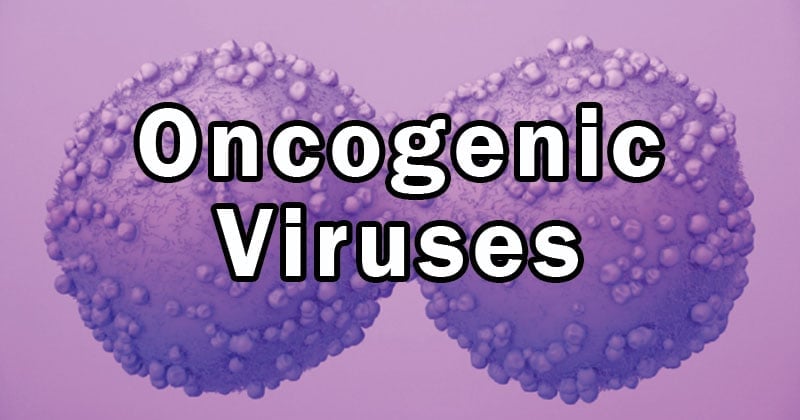- Viruses are intracellular pathogens that reproduce only in the living cell and manipulate the cellular machinery to produce more viruses.
- Viral replications can affect the cellular genes of the host in multiple cancerous ways.
- An oncovirus is a virus that can cause cancer.
- Viruses account for about 20% of total human cancer cases.
- Although many viruses can cause various tumors in animals, only seven of them are associated with human cancers and are currently considered oncogenic viruses.

Image Source: Massachusetts Institute of Technology
Interesting Science Videos
Introduction
- These viruses include hepatitis B virus (HBV), hepatitis C virus (HCV), human papillomavirus (HPV), Epstein Barr virus (EBV), human herpes virus 8 (HHV8), Merkel cell polyomavirus (MCPyV), and HTLV-1.
- HBV and HCV cause approximately 80% of hepatocellular carcinoma (HCC), the most common cancer of the liver.
- High-risk HPV strains are the major causes of cervical cancer and other ano-genital neoplasms as well as a significant proportion of head and neck tumors.
- EBV is associated with nasopharyngeal carcinoma, Hodgkin’s lymphoma, and Burkitt’s lymphoma.
- HHV8 (also called Kaposi’s sarcoma-associated herpesvirus, KSHV) is responsible for Kaposi’s sarcoma often found in patients with acquired immunodeficiency syndrome (AIDS).
- MCPyV causes Merkel cell carcinoma and HTLV-1 is the causative agent of adult T-cell lymphoma.
Hepatitis B Virus (HBV) and Hepatitis C Virus (HCV)
- HBV and HCV can cause a liver infection that can sometimes lead to liver cancer.
- You pick up these viruses if you share needles used to inject drugs, have unprotected sex, or get a transfusion with contaminated blood.
- Doctors treat HBV and HCV infections with medicine.
- You can often get rid of HCV after a few months of treatment.
- Medication doesn’t cure HBV, but it can lower the chance of liver damage and liver cancer.
- There’s a vaccine to prevent HBV, but not HCV. Those with higher chances of getting HBV should get vaccinated. That includes people who have HIV, inject illicit drugs, or are health care workers.
Kaposi Sarcoma-Associated Herpesvirus (KSHV)
- KSHV is a herpes virus that can cause Kaposi sarcoma, a cancer of the blood vessels, as well as two types of lymphoma.
- You’re more likely to get cancer from KSHV if you have a weakened immune system because you had an organ transplant, get chemotherapy, or have AIDS.
- The virus can be spread during sex, and also through blood and saliva.
Merkel Cell Polyomavirus (MCV)
- MCV is a common virus that infects the skin.
- It usually doesn’t cause symptoms or lead to cancer. But in some people, MCV causes a rare skin cancer called Merkel cell carcinoma.
Human Papillomavirus (HPV)
- HPV is a group of more than 200 viruses, and at least a dozen of them can cause cancer.
- HPV spreads during vaginal or anal sex.
- HPV often goes away on its own and doesn’t cause any health problems. Some people stay infected, though.
- If they have the HPV that causes cancer, it can lead to cancers of the cervix, vulva, vagina, penis, anus, tonsils, or tongue.
- HPV vaccines can keep you from getting infected with the virus. Health officials recommend them for young women through age 26 and young men through age 21.
Human T-Cell Lymphotropic Virus Type 1 (HTLV-1)
- HTLV-1 infects T cells, which are a type of white blood cell. It can cause leukemia and lymphoma.
- HTLV-1 spreads several ways, including: From mother to child during birth or through breastfeeding, sharing needles with infected people, organ transplant, unsafe sex, etc.
- About 2% to 5% of people who have the virus get adult T-cell leukemia or other health conditions. It’s not clear why some people get leukemia and others don’t. Symptoms and how it develops are different for each person.
- There isn’t a cure or treatment for HTLV-1. It’s a lifelong condition. But regular checkups can lower your chances of cancer.
Epstein-Barr Virus (EBV)
- EBV is a common virus. Most people get infected with it at some point in their lives. Most of the time, people with EBV stay healthy and don’t have symptoms.
- For others, EBV can cause mononucleosis and other more serious conditions, from viral meningitis to pneumonia.
Several cancers are linked with EBV as well:
- Burkitt’s lymphoma
- Nasopharyngeal carcinoma (cancer of the upper throat)
- Hodgkin’s and non-Hodgkin’s lymphoma
- T-cell lymphomas
- Post-transplant lymphoproliferative disorder (too many white blood cells)
- Leiomyosarcoma (cancer in the soft tissue)
- There’s no vaccine for EBV, but you can help protect yourself by not kissing or sharing drinks, food, or personal items with someone who has the virus.
- There’s no specific treatment if you have EVB, but you can ease symptoms if you drink plenty of fluids, get rest, and take medicines for pain and fever.
Mechanisms of Viral Oncogenesis
The molecular mechanisms of viral oncogenesis are complex and may involve:
- Induction of chronic inflammation
- Disruption of host genetic and epigenetic integrity and homeostasis
- Interference with cellular DNA repair mechanisms resulting in genome instability
- Cell cycle dysregulation.
- Oncogenic DNA viruses can also insert their genomic DNA into cellular chromosomes, resulting in genetic abnormity.
- Viral ‘oncoproteins’ can activate cellular signaling pathways, alter the expression of cellular genes and microRNAs either transcriptionally or post-transcriptionally, and destabilize or inactivate tumor suppressor proteins and proteins that regulate cell polarity, signal transduction, immune response, and apoptosis.
- Genetic and epigenetic alterations induced by infection and replication of oncogenic viruses may lead to the appearance and proliferation of cancer stem cells, which are important for the initiation, progression, metastasis, relapse, and chemotherapy resistance of cancers.
The importance and underlying molecular mechanisms of specific cellular genes and signaling pathways in viral oncogenesis are subjects of intense research efforts.
References
- https://www.ncbi.nlm.nih.gov/pmc/articles/PMC4731227
- https://www.ncbi.nlm.nih.gov/pubmed/27830995
- https://www.asm.org/Articles/2019/January/The-Seven-Viruses-that-Cause-Human-Cancers
- https://www.nature.com/articles/onc2009351
- https://www.nature.com/articles/nrc3400
- https://www.webmd.com/cancer/viruses-that-can-lead-to-cancer#3
- https://www.microrao.com/micronotes/oncogenic_viruses.htm
- https://www.onlinebiologynotes.com/oncogenic-viruses
